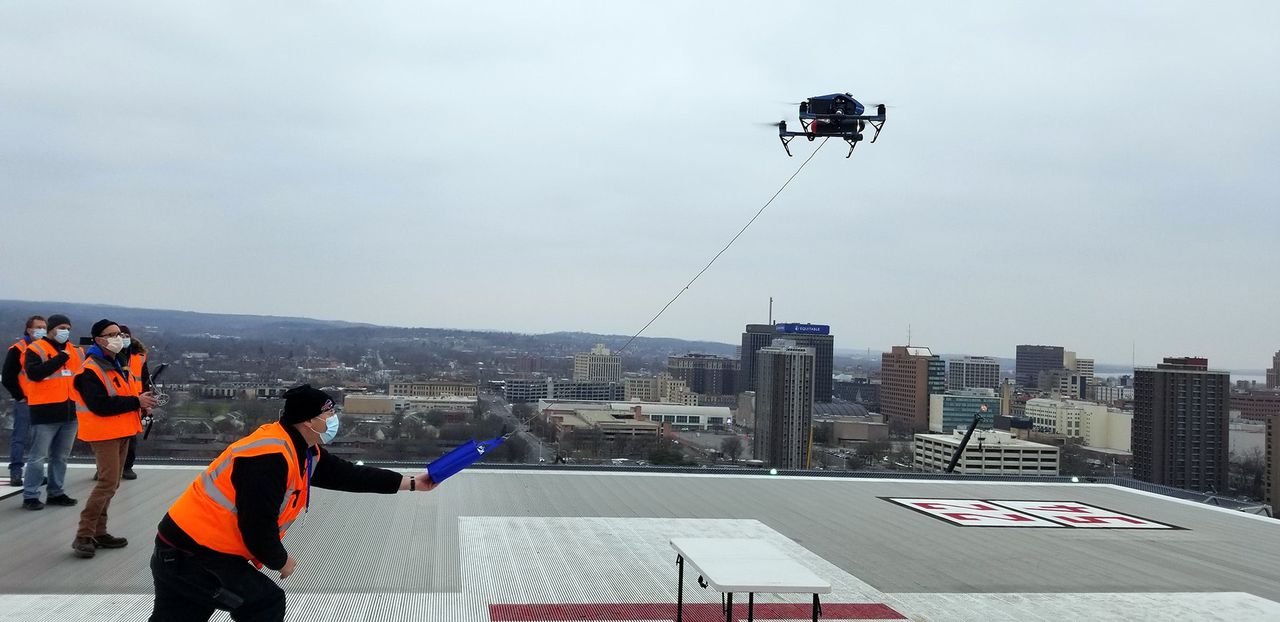
New York’s Syracuse hospital and its drone industry partners have successfully completed a year-long trial of unmanned aerial vehicle medical deliveries, yet doubts remain about when those operations may become reality.
Moving sensitive medical payloads faster by drone
The test run sought to establish the feasibility of making rapid medical deliveries via drone between the rooftops of Syracuse medical facilities. The trial dispatched medical supplies between various State University medical or laboratory buildings. In one January flight, an unused COVID-19 test was flown between structures in only two minutes, compared to seven using habitual land transport routes. Others similarly slashed delivery times over normal options.
The successful trial was conducted by partners SUNY Upstate Medical University, Virginia-based drone services company DroneUp, and New York’s Northeast UAS Airspace Integration Research Alliance (Nuair). The objective was to clearly demonstrate the utility of drones in time-critical deliveries of medical materials. In real situations, those might include organs, blood products, or tissue samples removed during surgery and needing fast analysis in a remote lab.
In addition to embracing new, efficiency enhancing technologies to enhance future performance, the partners also launched the initiative in anticipation of looming complications they know they’ll soon face. An elevated state interstate that runs next to Syracuse hospital – and separates it from a surgical center and other buildings – is set for set for major construction. Consequently, officials want to find fast, efficient alternative transport options ahead of even slower ground travel once work begins.
But as perfect a solution as drones seem to be for the Syracuse situation, considerable hurdles must be cleared before those test runs can become an operational fact. Regulations for starters.
Tests done, waiting on FAA approval
The Federal Aviation Administration (FAA) currently bans a wide array of medical material from being transported by drone due to the risks they’d pose people were the craft to crash. The FAA is still evaluating which kinds of drone it may eventually approve for medical deliveries – probably only those with six to eight motors that can remain aloft even if one or two engines fail.
For its part, the Syracuse alliance is proposing several precautionary measures to encourage FAA clearance. It has said it will equip drones with parachutes for use in case of engine trouble. It has also suggested using special, protective payload containers to limit third-party exposure to delivered supplies.
But even if the FAA eventually agrees, wrinkles closer to Syracuse’s operational home will need to be ironed out. To begin with, the five people required to carry out each test flight will need to be considerably reduced to become financially viable. Meantime more motors on drones will drain batteries faster. And finally, there’s the brutal Upstate NY winter weather to deal with.
Undaunted, however, Nuair CEO Tony Basile told Syracuse.com that use of drones in medical deliveries is a question of when, not if. “I think they’re certainly going to be used,” Basile stressed. “Whether it’s soon depends on what you mean by soon.”
FTC: We use income earning auto affiliate links. More.




Comments